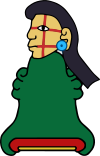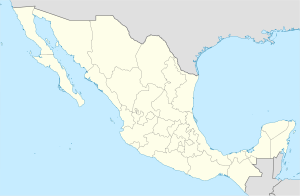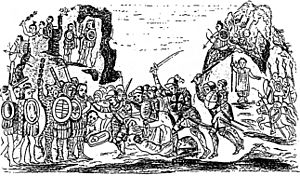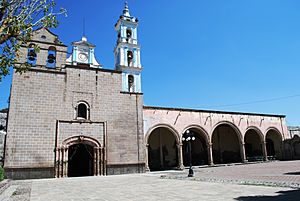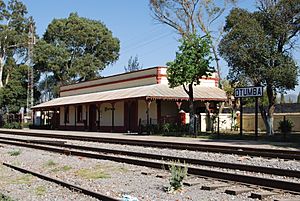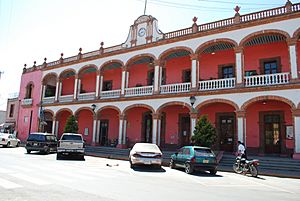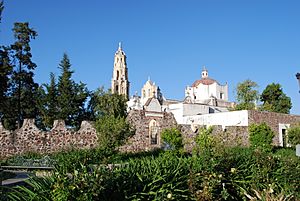Otumba de Gómez Farías facts for kids
Quick facts for kids
Otumba de Gómez Farías
Otumba
|
||
|---|---|---|
|
Town
|
||
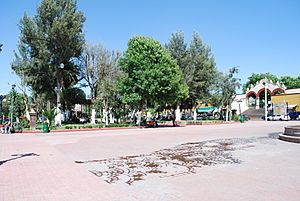
Main plaza
|
||
|
||
| Country | ||
| State | State of Mexico | |
| Municipality | Otumba | |
| Founded | 1200s | |
| Elevation
(of seat)
|
2,360 m (7,740 ft) | |
| Population
(2005)
|
||
| • | 9,242 | |
| Time zone | UTC-6 (Central (US Central)) | |
| • Summer (DST) | UTC-5 (Central) | |
| Postal code (of seat) |
55900
|
|
Otumba, also known as Otumba de Gómez Farías, is a town in the State of Mexico. It is the main town, or municipal seat, of the Otumba municipality. You can find it in the northeast part of the state, not far from Mexico City.
This area is famous for the Battle of Otumba, a key event in Mexican history. It was also an important meeting point during the time when Spain ruled Mexico. New leaders, called viceroys, would meet their predecessors here to officially take power.
Today, Otumba is a rural area that is slowly becoming more urban as Mexico City grows. But one thing from the past is still very important: donkeys! Long ago, Otumba was a big market for these animals. Even now, donkeys are a special part of the local culture. Every year, Otumba hosts a fun event called the Feria de Burros, or Donkey Fair. Donkeys get to be stars in fashion shows, costume contests, and even races! There's also a special place called a donkey sanctuary for donkeys that need a home.
The name Otumba comes from the Nahuatl language. It means "place of otomis," referring to the Otomi people. The extra part, "Gómez Farías," was added to honor Valentín Gómez Farías, an important Mexican leader. The ancient Aztec symbol for Otumba shows an Otomi person with a sign for "place." This symbol and a Spanish coat of arms represent the municipality today.
Contents
History of Otumba
Early Settlements and Aztec Rule
The Otomi people likely settled this area first. Some say these Otomi came from the Chichimeca people. Several villages appeared here between 200 and 900 AD. The first known ruler was named Motolina. Around 1200, when the chiefdom of Xaltocan fell, many other Otomis came to Otumba for safety and founded the town.
Later, the area came under the rule of Azcapotzalco and its leader, Tezozomoc. Then, Nezahualcoyotl from Texcoco established Aztec rule. He made Otumba an important regional capital. It was a place where taxes and tributes were collected.
As an Aztec city, Otumba had a special sacred plaza with a temple. There might have been a palace for the local lord too. Outside this plaza lived the elite, called the pipiltin, in large family homes. There was probably a central market as well. Further out lived the common people, called the macehualtin. The city's layout was similar to Texcoco, but smaller. Evidence shows that Otumba produced many crafts, like pottery.
The Battle of Otumba
The Battle of Otumba is a famous part of the story of the fall of Tenochtitlan, the Aztec capital. It happened after the Spanish had to flee Tenochtitlan during an event known as La Noche Triste (The Sad Night). The Spanish wanted to reach Tlaxcalan territory, where they had allies.
As Hernán Cortés and his soldiers fled towards Tlaxcala, they were stopped by a large group of warriors. These warriors came from Tenochtitlan, Tepanec, Xochimilco, and other groups. Even though the warriors had seen horses before, seeing Spanish knights in full armor in open battle was a big shock.
The battle lasted for four hours. Finally, Cortés and thirteen knights charged the enemy leader, Cihuacóatl Matlatzincatzin, and killed him. This brave charge broke the warriors' lines, and they fled. This victory earned Otumba the name "La Heroica Otumba" (Heroic Otumba). Even though the Spanish army was tired and had lost many men, they won against a much larger Aztec force. They were then able to reach Tlaxcala to rest and plan their next moves. About 20,000 Aztecs were killed in this battle. While the town gives its name to this battle, the actual fight happened in a place called Temalacatitlán.
After the battle, people from Otumba and nearby areas sent messengers to Cortés. They asked for forgiveness for fighting against him with the Aztecs. Cortés then asked the people of Otumba to capture the messenger from Tenochtitlan as proof of their loyalty.
Otumba in the Colonial Period
After the Spanish conquest of the Aztec Empire, Cortés visited Otumba again. He was on his way to visit mines in Pachuca. The Spanish divided Otumba into several encomiendas, which were grants of land and people to Spanish settlers. Many of these belonged to Cortés himself.
When Cortés went to Spain in 1528, the Otumba area was taken by Nuño de Guzmán. He declared it a province of the Spanish crown. But when Cortés returned, he took Otumba back. He made his son, Martín Cortés, the person in charge of collecting tribute there.
For the rest of the time Spain ruled Mexico, Otumba was a very important stop. It was on the main roads that connected Mexico City to other important places like Puebla, Hidalgo, and especially the port of Veracruz. It was also the place where new viceroys would meet the old ones. They would receive the symbol of power before entering Mexico City. Because of all the travel and trade, Otumba grew into a busy commercial center during this period.
Otumba in Modern Mexico
During the Mexican War of Independence, an important rebel leader named Eugenio Montaño came from Otumba. He fought in the Apan area until 1813. Royalist forces defeated his troops near Calpulalpan. Montaño was killed, and his body was found. As an act of revenge, the royalists cut off his head and cut his body into four pieces. His head was sent to his family, and his body parts were hung at the four corners of his house in Otumba. The local priest tried to bury the body, but the royalists dug it up and rehung the pieces. Later, the body was finally buried in the church's baptistery.
In 1827, Guadalupe Victoria announced his Montano Plan here. Also, in 1839, Nicolás Bravo was declared the president of Mexico in Otumba.
For much of its history, Otumba was a district seat. It became an official municipality in 1821. In 1861, it was officially declared a town. A railway line was built through Otumba in the late 1800s. The municipal palace was built in 1890. A second railway line was added in the mid-1900s.
The train station became important during the Mexican Revolution. In 1915, General Rodolfo Fierro, who was allied with Francisco Villa, took over the local telegraph station. He sent fake orders in Álvaro Obregón's name to Obregón's troops. These orders helped Villa's army. Another event was an attack on a train called El Dorado, which was carrying Venustiano Carranza. Forces loyal to Alvaro Obregon carried out the attack, but they did not succeed in killing Carranza.
Ángel María Garibay K., a famous linguist and expert in church law, was the priest of Otumba from 1932 to 1941. He wrote many important books while living here.
Otumba Today
Today, the municipality of Otumba is changing. It is becoming more urban, meaning more like a city. With these changes, crime rates have gone up, and local people are sometimes frustrated.
The municipality is home to the Topochico prison. In 2009, over twenty prisoners started a revolt in the maximum security area. They claimed they were being mistreated. Two prison workers were taken hostage, and the riot spread. Authorities took back control of the prison about eight hours later.
Exploring the Town of Otumba
For several years, the government has been working to restore and beautify Otumba. The goal is for it to be named one of the "Pueblos con Encanto del Bicentenario" (Bicentennial Towns with Charm). This program started in 2008, and Otumba was one of the first towns chosen. The hope is that these improvements will attract more tourists.
Like most towns in Mexico, the center of Otumba has a main plaza. Important buildings surround this plaza. The main plaza has leafy trees and a kiosk with a small café inside. Around the plaza, you'll find the Parish of the Purísima Concepción, the municipal palace, and the Gonzalo Carrasco Museum.
Parish of the Purísima Concepción
The Parish of the Purísima Concepción started as a Franciscan monastery. It was likely built in the 1530s. The church became a parish in 1603, and many parts of it date back to the 1700s. It was a very important and popular building in the early colonial period. The church was built on top of an ancient Aztec platform.
On its saint's day, the town of Otumba creates a beautiful carpet of flower petals on the church's atrium. They also add decorative flower arches, traditional dances, and serve delicious foods like barbacoa and mole.
A stone monument from the colonial era, called La Picota, stands in the church's atrium. It was broken after the Mexican War of Independence, making it shorter. This is where new viceroys used to symbolically receive power from the old viceroys. Breaking the column might have been a way for people to show they rejected the old colonial system.
The church's main entrance, or portal, is in the Plateresque style. It has an arch framed by thin columns with sculpted vines and flowers. The door is surrounded by an alfiz, a decorative frame that is also seen in the choir area. The inside of the church has a curved ceiling, called a barrel vault, likely from the 1700s. The front of the cloister has an open chapel with simple designs and murals inside.
Municipal Palace
The municipal palace is a serious-looking building built in a Neo-colonial style. Its front has two levels of arches with windows and iron balconies. These details make the building look older, but it was actually built in the 1900s. It was designed this way to match the colonial look of the building it replaced.
Gonzalo Carrasco Museum and Cultural Center
The Gonzalo Carrasco Museum and Cultural Center is in the house where the famous painter Gonzalo Carrasco was born. It's on one side of the main plaza. This house is considered an important architectural monument. It was traditionally called Portal El Fénix and belonged to the Carrasco family, who were merchants.
Gonzalo Carrasco was a Jesuit priest, a theologian, and a painter. He was active in the late 1800s and early 1900s. He studied at the Academy of San Carlos and with José María Velasco. His artwork can be seen in many buildings in Mexico and other countries.
Portal El Fénix is a two-story building with a central courtyard. The ground floor had businesses like a general store, hairdressers, and a wine shop. The family lived upstairs. Several rooms have been restored to look like they did in the late 1800s and early 1900s. The most famous part of the building was the Tienda Grande (Large Store). This name eventually referred to the whole building. It was at the front, under the balconies. Here, people bought everyday items like bread, fabric, wax, and grains. This house burned down in 1876 but was rebuilt.
Local people started restoring the building in the late 1900s. It opened in 1981 as the Casa de Cultura y Museo Gonzalo Carrasco. It has eleven rooms. Five rooms display ancient pieces from the Aztec, Teotihuacan, and Otomi cultures. There are also photos of old books (codices), buildings, the construction of the Otumba railway, and old farms (haciendas) that made pulque. Other rooms, like the dining room, bedrooms, kitchen, and living room, are set up as the family lived in them, with some original furniture. One room is dedicated to Carrasco's artwork.
Railroad Museum
Just outside the main plaza, you'll find the old railroad station. When it was built, Otumba became a key place for communication and for shipping pulque to Mexico City. The first permission for a railway through Otumba was given in 1837, but it was later canceled. Small parts of a railway line were built here and started service in 1873. It carried passengers and goods between Mexico City and points to the east and south.
The current station was built in 1906. It was part of the Mexico City-Veracruz line of the old Ferrocarril Mexicano. The station was no longer used after 1995 when the railway system became private. Today, the station is a museum for the municipality, called the Museo del Ferrocarril en Otumba (Railroad Museum in Otumba). It has exhibits like a copy of the first train ticket ever issued in Mexico. You can also see a restored telegraph office and old photographs from the late 1800s and early 1900s.
Local Food
At the municipal market, you can find many tasty local dishes. These include tlacoyos, quesadillas made with squash flowers, mushrooms, barbacoa, mixiote, mole, and pulque. During certain seasons, you might find more unusual dishes like maguey larvae, chinicuiles, escamoles, and snails.
Donkey Fair and Sanctuary
Otumba was a major center for buying and selling donkeys during the colonial period. This was because it was at a crossroads of important roads leading into Mexico City. Many donkeys passed through, carrying goods and people. Donkeys were used well into the 1900s because many roads in Mexico were in poor condition. Trucks couldn't easily reach farms and haciendas that produced pulque, milk, and cactus fruit. Even though Otumba is becoming more urban, the donkey is still a valuable part of the culture. In some places, they are still used for work.
Feria del Burro (Donkey Fair)
The Feria del Burro (Donkey Fair) started in 1965. It is the oldest annual fair in the State of Mexico. The fair began as part of a celebration for the Señor de Animas, which is no longer celebrated. The main stars of the fair are the donkeys, and they are presented in many fun ways. There's donkey polo, costume contests where donkeys dress up as famous people, a donkey race around the main plaza, and a big parade with floats.
The fair also has traditional festival attractions. These include sports events, local food, fireworks, and folk dances. There's a crafts expo with over 85 producers showing 17 different types of crafts. There's even a Crafts Contest. Money from the event has been used to improve the town, like burying electric and telephone cables. This yearly event has attracted as many as 50,000 visitors!
Burrolandia (Donkey Sanctuary)
Burrolandia, or the Donkey Sanctuary of Mexico, is an animal shelter just for donkeys. It cares for about twenty animals. The Flores family started Burrolandia in 2006 on land next to their home. It's not a fancy place; donkeys wander around old cars from the 1940s. Visitors get donkey ears and tails to wear and can visit a small museum. There are also papier-mâché donkeys, puppet shows, and donkey rides.
Burrolandia gets its support from donations from visitors, local companies, and international groups like the Donkey Sanctuary in Britain. Even though donkeys have been historically important in Mexico, farmers now prefer pickup trucks and tractors, even in poorer areas. While donkeys are still culturally important, the lack of work means they are often seen as a burden. The donkey population in Mexico dropped from one million in 1991 to about 581,000 in 2007. Another reason farmers get rid of donkeys is that they are sometimes linked to old-fashioned ways. Now, donkeys are not even worth much money. This is why Otumba started the sanctuary and other projects, like offering free vet care for donkeys still on farms.
The Municipality of Otumba
The town of Otumba is the main governing center for over eighty other communities. The municipality covers an area of 143.42 square kilometers. The total population of the municipality is 29,873 people, but less than a third of them live in the town of Otumba itself. The municipality shares borders with Axapusco, Tepetlaoxtoc, San Martín de las Pirámides, and the states of Tlaxcala and Hidalgo.
Geography and Climate
About 15% of the land in the municipality is rugged mountains, 40% is rolling hills, and 45% is flat. The elevation ranges from 2,300 to 2,900 meters (about 7,500 to 9,500 feet) above sea level. It includes mountains like Las Bateas, San Pedro, La Charra, Pelón, and La Cruz. There are no permanent rivers, but there are streams like El Soldado and San Vicente that flow during the rainy season.
The climate is mild to moderately cold and dry. You can find wild maguey and nopal cactus growing here. Less than 8% of the land is covered by forests. High temperatures can reach 31°C (88°F) in the summer, and winter lows can be -2.3°C (28°F). Wild plants and animals are mostly found at the highest elevations. These include pines, willows, mimosas, jacarandas, squirrels, armadillos, opossums, coyotes, and various reptiles and insects.
Economy and Crafts
About 59% of the municipality's land is used for farming. This farming relies on both seasonal rains and irrigation. The main crops are cactus fruit and nopal. Farmers also raise animals like chickens, horses, sheep, goats, pigs, and cattle.
Industry here is small-scale. It produces things needed locally, such as processed foods, textiles, furniture, and bricks. Most businesses are also local. People also make crafts on a small scale, working with fine woods, obsidian, and onyx.
Historical Sites and Haciendas
The municipality has several interesting places to visit, but they are not fully used for tourism yet. One of these is the former monastery of Oxtotipac. The Franciscans built it on the site of an Aztec sacred area, or teocalli. The building is in the Plateresque style and is dedicated to San Nicolas de Bari.
The front of the building looks a bit like a special container for holy objects. It has two round windows and a main entrance with five arches and beautifully carved columns. This front part dates from 1675. It is more decorated than most Franciscan monasteries, with plant designs. The columns inside are delicately carved stone. They mix Renaissance and Romance styles with Otomi designs. The monastery has two baptismal fonts, one from the 1500s.
This monastery recently had a four-year restoration project that cost about 700,000 pesos. A group called Adopte una Obra de Arte (Adopt a Work of Art) and the State of Mexico helped fund the work. A big problem for the monastery was the theft of its religious art, so new security was added. Inside and outside walls were fixed, and three altarpieces were cleaned and restored, along with other sculptures and paintings. The cloister area now holds a collection of original artworks from the monastery.
In some smaller communities, like Huayapan and Soapayuca, about 80% of the buildings are old, not modern. Many of their fronts have been renovated. Several old haciendas (large estates) in the municipality have been restored and given new uses. Haciendas in this area started producing pulque after cattle had eaten too much of the pastures.
The San Antonio Xala Hacienda was a pulque hacienda from the 1800s. Now, it's a hotel and restaurant. Its elegant rooms and main chapel are open for visitors. Another San Antonio Xala Hacienda has been turned into a rustic vacation center. It has cabins, horse facilities, a pool, an event hall, and a car from one of the first trains in the region. It also has a restaurant that serves local food, including breads and cheeses made right there. The Soapayuca Hacienda now houses offices for the Adidas Corporation. Its courtyard has a grand fountain, and its chapel has a unique image of Christ at the entrance.
The former Santa María de Guadalupe Tepa Hacienda has an ancient ceremonial mound, 40 meters (about 130 feet) wide. Other structures there date from the Teotihuacan period. In the mid-2000s, the state government allowed the municipality to use the land for ball fields and a cemetery. However, this work was stopped by INAH (Mexico's National Institute of Anthropology and History) to protect the ancient ruins.
The San Antonio Ometuxco Hacienda is about 15 kilometers (9 miles) outside the town of Otumba. According to older residents, the main house used to shine in the sun because of its beautiful ceramic tiles. Today, you can still see Roman-style statues, pieces of Talavera tile, and leafy trees. This hacienda belonged to Ignacio Torres Adalid, who was a tax director during the time of Porfirio Díaz. After that, it belonged to a foreigner, and then to a group of ten farmers who sold it in 1910. It was sold to another foreigner in 1978, who still owns it but has left it empty. The rooms have old furniture and other items. The most valuable parts are the house's murals, paintings, fountains, and gardens, along with religious figures in the chapel. This was also a pulque-producing hacienda. The tinacal, or production area, still remains. It's made of wood with thick beams and has murals about the history of pulque.
The small community of Apaxco claims to have one of the most beautiful churches in the region, called the Temple of San Esteban Axapusco. It has been restored with new paint and gold leaf. The main altarpiece shows the family tree of Jesus. The walls have murals of the Twelve Apostles from the 1600s. Other attractions include caves in Oztotipac, which were once lived in by the Chichimecas. There are also water parks and spas like Los Pajaritos and El Temascal.
|
See also
 In Spanish: Otumba de Gómez Farías para niños
In Spanish: Otumba de Gómez Farías para niños


